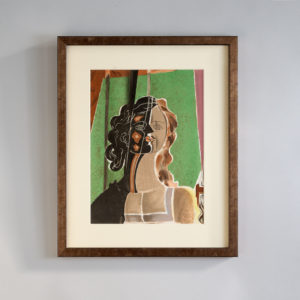7 items found
Page 1 of 1
-

Congolese Songye door
£480 -

Songye Kilumwe Kifwebe mask (A)
£350Songye Kilumwe Kifwebe mask (A)
Very large Kifwebe mask with exaggerated sagittal crest. It is believed that the sagittal crest and conical protrusion contain the magical strength of the mask.£350 -

Songye Janus standing power figure,
£325Songye Janus standing power figure,
Congolese double-faced maternal power figure, adorned with animal hide and cowrie shells. The Songye power figure serves to protect its community from evil spirits.£325 -

Songye standing male power figure,
£325Songye standing male power figure,
Standing male power figure from the Congolese Songye tribe, beautifully adorned with natural fibres, animal hide, and miniature power figure. These wooden power figures would have served to protect the Songye community from evil spirits and practitioners.£325 -

Songye Luba mask (A)
£280Songye Luba mask (A)
The people of Songye are mainly known as a farming community, however they also take part in hunting and trading with other neighbouring communities. The distinct Songye style is easily recognisable in the Kifwebe mask by the mass of closely carved lines and bold shapes such as the protruding sagittal crest and X carved mouth. The intertwining of the red, black, and white colouring in these masks are said to symbolise the struggle between good (white) and evil (black and red) - the combination of these colours embodying the positive and dangerous force held within the mask. The ruggedness of the Kifwebe mask and its long raffia beard are said to symbolise the underworld and the spirits that escape from it. Further, it is believed that the sagittal crest and conical protrusion contain the magical strength of the mask.£280 -

Songye Luba mask (B)
£200Songye Luba mask (B)
The people of Songye are mainly known as a farming community, however they also take part in hunting and trading with other neighbouring communities. The distinct Songye style is easily recognisable in the Kifwebe mask by the mass of closely carved lines and bold shapes such as the protruding sagittal crest and X carved mouth. The intertwining of the red, black, and white colours in these masks are said to symbolise the struggle between good (white) and evil (black and red) - the combination of these colours embodying the positive and dangerous force held within the mask. Further, it is believed that the sagittal crest and conical protrusion contain the magical strength of the mask.£200 -

Luba Bilume Kifwebe mask (A)
£175Luba Bilume Kifwebe mask (A)
The people of Songye are mainly known as a farming community, however they also take part in hunting and trading with other neighbouring communities. The distinct Songye style is easily recognisable in the Kifwebe mask by the mass of closely carved lines and bold shapes such as the protruding sagittal crest and X carved mouth. The intertwining of the red, black, and white colouring in these masks are said to symbolise the struggle between good (white) and evil (black and red) - the combination of these colours embodying the positive and dangerous force held within the mask. Further, it is believed that the sagittal crest and conical protrusion contain the magical strength of the mask.£175
Featured Items
-

Portraits Part I by Constantin Guys, Verve Vol 2 / No. 5-6.
£500Portraits Part I by Constantin Guys, Verve Vol 2 / No. 5-6.
The Verve Review was a purposefully luxurious. It ran from 1937 to 1960, but with only 38 editions available, due to the high degree of design and editorial work dedicated to each issue. Each edition contained unique lithographic prints, commissioned by the editor, and each cover a double-page lithograph elaborated by one of the artists contained within. It was the brainchild of its editor Stratis Eleftheriades, a Greek National who moved to Paris in the early thirties to take part in the growing Modernist movement, writing under the name of Teriade.£500 -

The Dance, by Henri Matisse, Jan – March 1939 / No. 4.
£1,200The Dance, by Henri Matisse, Jan – March 1939 / No. 4.
The Verve Review was a purposefully luxurious. It ran from 1937 to 1960, but with only 38 editions available, due to the high degree of design and editorial work dedicated to each issue. Each edition contained unique lithographic prints, commissioned by the editor, and each cover a double-page lithograph elaborated by one of the artists contained within. It was the brainchild of its editor Stratis Eleftheriades, a Greek National who moved to Paris in the early thirties to take part in the growing Modernist movement, writing under the name of Teriade.£1,200 -

Portrait by Andre Derain, Verve Vol 2 / No. 5-6.
£800Portrait by Andre Derain, Verve Vol 2 / No. 5-6.
The Verve Review was a purposefully luxurious. It ran from 1937 to 1960, but with only 38 editions available, due to the high degree of design and editorial work dedicated to each issue. Each edition contained unique lithographic prints, commissioned by the editor, and each cover a double-page lithograph elaborated by one of the artists contained within. It was the brainchild of its editor Stratis Eleftheriades, a Greek National who moved to Paris in the early thirties to take part in the growing Modernist movement, writing under the name of Teriade.£800 -

Figure by Georges Braque, Verve Vol 2 / No. 5-6.
£800Figure by Georges Braque, Verve Vol 2 / No. 5-6.
The Verve Review was a purposefully luxurious. It ran from 1937 to 1960, but with only 38 editions available, due to the high degree of design and editorial work dedicated to each issue. Each edition contained unique lithographic prints, commissioned by the editor, and each cover a double-page lithograph elaborated by one of the artists contained within. It was the brainchild of its editor Stratis Eleftheriades, a Greek National who moved to Paris in the early thirties to take part in the growing Modernist movement, writing under the name of Teriade.£800
